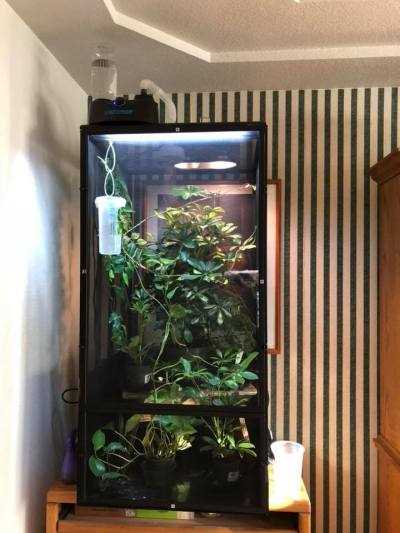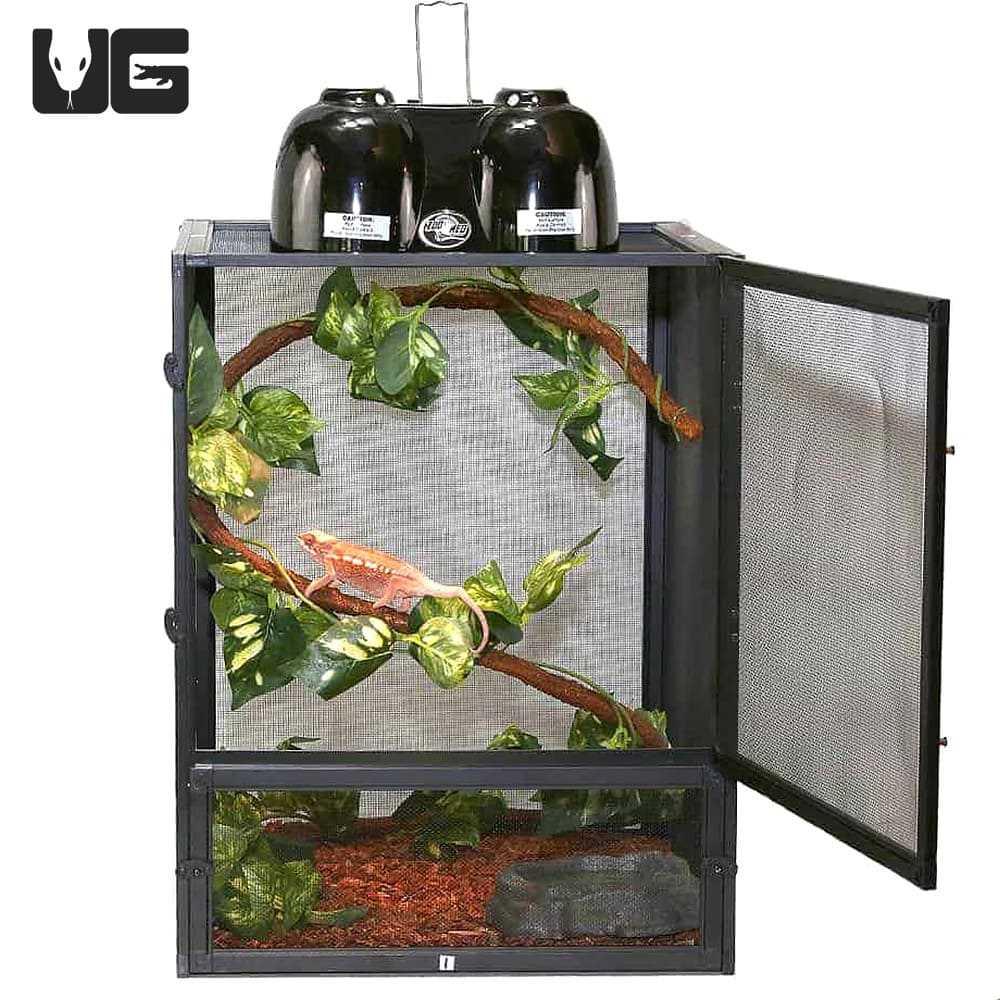
A chameleon’s cage should provide ample space for them to move around and climb. These arboreal creatures need vertical space to explore their surroundings, so a taller cage with branches and vines for them to climb is essential. Additionally, the cage should be spacious enough to allow for the installation of various accessories, such as heat lamps and UVB lighting.
The substrate in a chameleon’s cage is also important. It should mimic their natural habitat and provide a comfortable surface for them to walk on. Substrate options include sphagnum moss, coconut coir, or a combination of both. It is crucial to avoid using any harmful substrates that may cause harm or illness to the chameleon.
Ensuring the chameleon’s cage has proper temperature and humidity levels is crucial. The temperature inside the cage should have a gradient, with a cooler area for the chameleon to retreat to and a warmer basking spot. Regular monitoring and adjustments may be necessary to maintain optimal conditions. Humidity levels should also be monitored and kept within the appropriate range for the specific species of chameleon.
Finding the Perfect Home for Your Pet Chameleons
1. Size Matters: Chameleons need ample space to climb and move around. Therefore, the size of the cage should be large enough to accommodate their natural behavior. Ideally, the cage should be at least two or three times the length of your chameleon, allowing them to explore and exercise.
2. Ventilation is Key: Chameleons require good airflow in their habitat. Look for a cage that provides adequate ventilation to prevent the buildup of humidity and maintain a healthy environment for your pet. A mesh or wire screen on the sides of the cage can help ensure proper air circulation.
3. Material Matters: The material of the enclosure is also important. Chameleons are arboreal creatures and need a cage that is suitable for climbing. A cage made of strong and durable materials, such as mesh or PVC, is ideal as it can withstand their climbing and provide a secure environment.
4. Branches and Perches: Chameleons love to climb and perch on branches. Make sure the cage has ample branches or perches of varying diameters and heights. These will not only provide your chameleons with exercise and entertainment but also mimic their natural habitat.
5. Lighting and Heating: Chameleons require specific lighting and heating conditions to thrive. Ensure that the cage has suitable fixtures for UVB lighting, which is essential for their calcium metabolism, and a heat source to maintain the proper temperature gradient. It is recommended to consult with a reptile specialist to ensure you provide the right lighting and heating setup for your chameleons.
By considering these factors and finding the perfect home for your pet chameleons, you can provide them with a comfortable and safe environment that satisfies their natural instincts and promotes their overall well-being.
Height
Length and Width
In addition to the height, the length and width of the cage are also important factors to consider. Chameleons need space to move horizontally and should be able to stretch out and walk along the branches. The minimum recommended length and width of the cage should be three times the length of the chameleon’s body. This will give them enough room to comfortably move and explore.
Important Features to Look for

When choosing a cage for your chameleons, there are several important features to consider. These features will help create a comfortable and safe environment for your pet reptile.
1. Size
2. Ventilation
Chameleons need good air circulation in their cage to maintain proper humidity levels and prevent respiratory issues. Look for cages with adequate ventilation, such as mesh or screen panels. This will ensure that fresh air can flow through the cage while still maintaining the necessary humidity for your chameleons.
3. Lighting
Lighting is crucial for chameleons as it mimics natural sunlight and helps with their thermoregulation. Look for cages that have built-in lighting fixtures or have the capability to install UVB or full-spectrum lighting. These lights will provide the necessary UVB rays for your chameleons’ overall health and wellbeing.
4. Accessibility

5. Sturdy Construction
Chameleons can be quite active and will climb on the walls and branches in their cage. Therefore, it’s essential to choose a cage with sturdy construction that can withstand their movements. Look for cages made from durable materials, such as aluminum or PVC, that can handle the weight and activity of your chameleons.
By considering these important features when choosing a cage for your chameleons, you can provide them with a comfortable and safe environment that meets their specific needs. Remember to research and consult with experts to ensure the best possible housing for your beloved reptiles.
Creating a Comfortable and Safe Environment for Chameleons
Chameleons are unique creatures that require a specific environment to thrive. When setting up their cage, it is essential to focus on creating a comfortable and safe space for them. Here are some important factors to consider:
| Temperature | Chameleons are ectothermic, meaning they rely on external sources of heat to regulate their body temperature. It is crucial to provide a gradient of temperatures within their enclosure, allowing them to move around and find their preferred spot. A basking area should be provided with a heat lamp or ceramic heater to create a warm zone, while other areas should be cooler. |
| Humidity | |
| Lighting | Chameleons need access to both UVB and UVA light for proper calcium absorption and overall health. UVB light should be provided through a reptile-specific UVB bulb, while UVA light can be provided through a regular daylight bulb. It is crucial to ensure that the bulbs are properly installed and replaced according to their lifespan to maintain adequate lighting. |
| Substrate | |
| Branches and Plants | Chameleons are arboreal creatures, meaning they spend most of their time climbing and perching on branches and plants. It is essential to provide a variety of sturdy branches at different heights and angles within the enclosure. Live plants can also be added to create a more natural and visually appealing environment. Just make sure that the plants are non-toxic and safe for chameleons to prevent any ingestion issues. |
Creating a comfortable and safe environment is crucial for the health and well-being of chameleons. By considering factors such as temperature, humidity, lighting, substrate, and the presence of branches and plants, you can ensure that your chameleon thrives in its enclosure.

I’m Lena Adams—a product of an unconventional upbringing in the African wilderness. My father, a daring explorer of African wildlife, sparked my fascination with reptiles, a passion that intertwined with the tragic loss of my mother during an expedition, leaving an indelible mark on my life. Driven to understand the creatures that captivated my parents, I embarked on my journey, sharing insights about reptiles, frogs, and lizards on my website. Through my explorations and conservation efforts, I honour my family’s legacy while seeking connections—to the creatures, nature, and the mother whose presence I yearn to understand.
